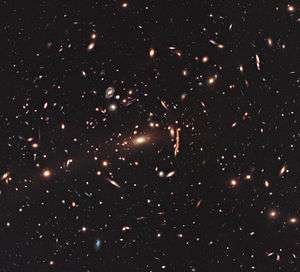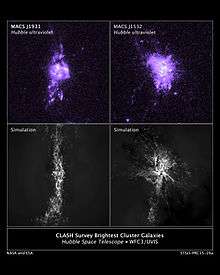Cluster Lensing and Supernova survey with Hubble
The Cluster Lensing And Supernova survey with Hubble (CLASH) was a program on the Hubble Space Telescope to observe 25 massive galaxy clusters. CLASH was one of three programs selected (along with CANDELS and PHAT) in the first class of Hubble multi-cycle treasury programs, which were designed to tackle large questions unanswerable through normal observations.[1] Observations for CLASH were conducted between November 2010 and July 2013.[2] CLASH was led by principal investigator Marc Postman, and had a science team of over 40 researchers.[2]
| Survey type | astronomical survey |
|---|---|
| Target | galaxy cluster |
| Observations | Hubble Space Telescope |

Primary observations for CLASH were conducted on the Hubble Space Telescope with the Advanced Camera for Surveys (ACS) and Wide Field Camera 3 (WFC3). Images were taken in 16 filters, which were selected to maximize the ability to detect distant galaxies behind each cluster.[3] Twenty of the observed clusters were selected due to their relaxed morphology in X-ray observations, while the other five were chosen due to their strength as gravitational lenses.
History

As of November 2012, the CLASH has surveyed 20 clusters out of the 25. One of the galaxy clusters, MACS J0647+7015 was found to have gravitationally lensed the most distant galaxy (MACS0647-JD) then ever imaged, in 2012.[5][6]
In 2013, one study utilizing CLASH data found that RX J1347.5-1145 had intense gravitational bending of light such that 8 images of the same object were detected.[7] (See Gravitational lensing)
Clusters under observation
List of clusters is:[8]
| Galaxy cluster | Right Ascension | Declination | Redshift | Notes |
|---|---|---|---|---|
| Abell 209 (ACO 209) | 01:31:52.57 | -13:36:38.8 | 0.206 | |
| Abell 383 (ACO 383) | 02:48:03.36 | -03:31:44.7 | 0.187 | |
| MACS0329.7-0211 | 03:29:41.68 | -02:11:47.7 | 0.450 | |
| MACS0429.6-0253 | 04:29:36.10 | -02:53:08.0 | 0.399 | |
| MACS0744.9+3927 | 07:44:52.80 | +39:27:24.4 | 0.686 | |
| Abell 611 (ACO 611) | 08:00:56.83 | +36:03:24.1 | 0.288 | |
| MACS1115.9+0129 | 11:15:52.05 | +01:29:56.6 | 0.352 | |
| Abell 1423 (ACO 1423) | 11:57:17.26 | +33:36:37.4 | 0.213 | |
| MACS1206.2-0847 | 12:06:12.28 | -08:48:02.4 | 0.440 | |
| CLJ1226.9+3332 (ClG J1226.9+3332) | 12:26:58.37 | +33:32:47.4 | 0.890 | |
| MACS1311.0-0310 | 13:11:01.67 | -03:10:39.5 | 0.494 | |
| RX J1347.5-1145 | 13:47:30.59 | -11:45:10.1 | 0.451 | [Notes 1] |
| MACS1423.8+2404 | 14:23:47.76 | +24:04:40.5 | 0.545 | |
| RXJ1532.9+3021 | 15:32:53.78 | +30:20:58.7 | 0.345 | |
| MACS1720.3+3536 | 17:20:16.95 | +35:36:23.6 | 0.391 | |
| Abell 2261 (ACO 2261) | 17:22:27.25 | +32:07:58.6 | 0.224 | |
| MACS1931.8-2635 | 19:31:49.66 | -26:34:34.0 | 0.352 | |
| RXJ2129.7+0005 | 21:29:39.94 | +00:05:18.8 | 0.234 | |
| MS2137-2353 | 21:40:15.18 | -23:39:40.7 | 0.313 | |
| RXJ2248.7-4431 (Abell 1063S / ACO 1063S) | 22:48:44.29 | -44:31:48.4 | 0.348 | |
| MACS0416.1-2403 | 04:16:09.39 | -24:04:03.9 | 0.42 | |
| MACS0647.8+7015 | 06:47:50.03 | +70:14:49.7 | 0.584 | |
| MACS0717.5+3745 | 07:17:31.65 | +37:45:18.5 | 0.548 | |
| MACS1149.6+2223 | 11:49:35.86 | +22:23:55.0 | 0.544 | |
| MACS2129.4-0741 | 21:29:26.06 | -07:41:28.8 | 0.570 | |
Notes
- One of the most X-ray luminous and most massive cluster known, with an X-ray luminosity in excess of 10^45^erg/s. Magellan Spectroscopy of the Galaxy Cluster RX J1347.5-1145: Redshift Estimates for the Gravitationally Lensed Arcs
References
- "Science Year in Review: Hubble 2011" (PDF). HubbleSite. Space Telescope Science Institute. Retrieved 3 February 2019.
- Postman, Marc. "CLASH: An Innovative Survey to Place New Constraints on the Fundamental Components of the Cosmos using the Hubble Space Telescope". Space Telescope Science Institute. Retrieved 3 February 2019.
- Postman, Marc; Coe, Dan; Benítez, Narciso; Bradley, Larry; Broadhurst, Tom; Donahue, Megan; Ford, Holland; Graur, Or; Graves, Genevieve; Jouvel, Stephanie; Koekemoer, Anton; Lemze, Doron; Medezinski, Elinor; Molino, Alberto; Moustakas, Leonidas; Ogaz, Sara; Riess, Adam; Rodney, Steve; Rosati, Piero; Umetsu, Keiichi; Zheng, Wei; Zitrin, Adi; Bartelmann, Matthias; Bouwens, Rychard; Czakon, Nicole; Golwala, Sunil; Host, Ole; Infante, Leopoldo; Jha, Saurabh; Jimenez-Teja, Yolanda; Kelson, Daniel; Lahav, Ofer; Lazkoz, Ruth; Maoz, Dani; McCully, Curtis; Melchior, Peter; Meneghetti, Massimo; Merten, Julian; Moustakas, John; Nonino, Mario; Patel, Brandon; Regös, Enikö; Sayers, Jack; Seitz, Stella; Van der Wel, Arjen (1 April 2012). "The Cluster Lensing and Supernova Survey with Hubble: An Overview". The Astrophysical Journal Supplement Series. 199 (2): 25. arXiv:1106.3328. Bibcode:2012ApJS..199...25P. doi:10.1088/0067-0049/199/2/25.
- "CLASH Survey Brightest Cluster Galaxies and Simulations". Retrieved 10 August 2015.
- Hubble helps find candidate for most distant object in the Universe yet observed
- Scientific Objectives of CLASH
- F. Köhlinger and R.W. Schmidt - Strong lensing in RX J1347.5-1145 revisited (2013)
- A bot will complete this citation soon. Click here to jump the queue arXiv:1106.3328.